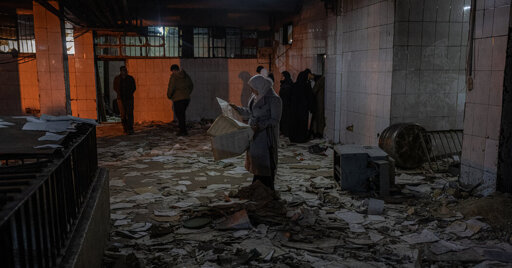archive.org. This archive doesn’t load everything so I’ve added screenshots of the article in the comments.
Syria Shudders as Assad’s Prison Atrocities Come Into the Light
At the country’s most notorious prison, Syrians confront their worst fears: that they will never know what happened to the loved ones who disappeared.
By Christina Goldbaum
People came by the thousands the day after the rebels arrived in Damascus, racing down the once desolate stretch of road, up a jagged footpath cut into the limestone hillside and through the towering metal gates of Syria’s most notorious prison. They flooded the halls lined with cells, searching for loved ones who had disappeared into the black hole of torture prisons under Bashar al-Assad’s government.
Some tore through the offices of the prison, Sednaya, looking for maps of the building and prisoner logs. One woman shoved a photograph of her missing son toward others walking by, hoping someone had found him. “Do you recognize him?” she pleaded. “Please, please, did you see him?”
In the entrance hall of one section, dozens of men with sledgehammers and pickaxes tore up the floors, convinced there were secret cells with more prisoners deep underground. Crowds swelled around them as people clambered to see what they found, pausing only when Israeli airstrikes landed close enough to shake the prison’s walls.
“Move back, move back!” one man, Ahmad Hajani, 23, yelled. “Let them work!”
Since a rebel coalition overthrew the Assad government last week, unchaining a country ruled by the iron fist of the Assad family for more than 60 years, thousands of Syrians in Damascus, the capital, have taken to the streets to revel in the city’s newfound freedom.
But amid the celebrations, the country has also found itself in the opening chapter of a nationwide reckoning over the horrors that Syrians endured under Mr. al-Assad’s government as they come face to face with the network of prisons, police stations and torture chambers at the center of his family’s brutal rule.
In that time, hundreds of thousands of Syrians were swallowed up by the Assad security forces’ vast apparatus. Over the past 13 years, after the failed rebel uprising and subsequent civil war, Mr. al-Assad wielded the long arms of that system as never before to stamp out every last inkling of dissent.
Protesters, activists, journalists, doctors, aid workers and students were snatched from their shops, plucked from university classrooms and yanked from their cars at checkpoints by the secret police — never to be heard from again.
Many ended up in Sednaya, the notorious prison on the outskirts of Damascus that was often the last place detainees were dumped after months of interrogation in other detention centers. The sprawling prison with three wings became a haunting symbol of Mr. al-Assad’s ruthlessness and the center of some of the worst atrocities committed during his rule.
Tens of thousands of people were crammed into the overcrowded cells, tortured, beaten and deprived of food and water. More than 30,000 detainees were killed, many executed in mass hangings, according to rights groups. Amnesty International called Sednaya a “human slaughterhouse.”
Their relatives lived in an agonizing limbo for years, unsure if their loved ones were alive. They went to local security officials every few months to beg for information and paid thousands of dollars in bribes to government officials to track down their relatives’ whereabouts. If security officers told them their disappeared relative was dead, many refused to believe them.
“They were liars,” one woman, Aziza Mohammed Deek, said of those in Mr. al-Assad’s government. “They were all liars.”
For the relatives, absent proof that their children, siblings or spouses had been killed, they clung to the hope that somewhere, somehow, they had survived. And so, after rebels swept into Damascus last week, throngs of people rushed to prisons and detention facilities across the country.
A few had the tearful reunions they long dreamed of. Many more are still searching, walking across the feces-smeared floors of prison cells, where recently released detainees say they begged for death.
As the week dragged on, thousands have been forced to confront a prospect they had long pushed out of mind: Their loved ones may never return home — at least not alive.
“I’m missing 40 people from my family,” said Bassam Bitaf, 38, standing outside Sednaya. “I have to know where they are, where have they disappeared to? What happened to them? Why can’t we find them?” Editors’ Picks Why Not Tell Someone They Look Great Today? Victor Brombert, Princeton Scholar With a Secret Army Past, Dies at 101 What Is (or Was) ‘Perks Culture’? The Prison
Sednaya was by most accounts the most fearsome torture prison of the Assad regime. So frightening were the reports of detainees’ being beaten, starved, bloodied and broken that few in Damascus even dared utter its name during Mr. al-Assad’s rule.
The building itself sits atop a hill on the outskirts of the city, surrounded by rows upon rows of iron fences and concrete walls topped with razor wire. On Monday morning, the brush outside the prison was smoldering — the rebels had set fire to the fields a day earlier, hoping the heat would detonate the land mines scattered across the hillside.
Nonetheless, later that afternoon, the earsplitting clap of a land mine exploding drew a throng of people to the top of an escarpment looking for what had happened. Hours later, crowds rushed to the escarpment again to catch a glimpse of the clouds of smoke from Israeli airstrikes pummeling a hilltop in the distance — which Israel says is part of its effort to destroy weapons and military facilities to keep them out of the hands of Islamist extremists.
Most prisoners in Sednaya were freed early last Sunday as rebels swept into the capital and the officers at the prison fled. But rumors persisted of a secret underground section, known as the “Red Wing,” where yet more prisoners might still be alive.
“They say it’s three stories underground,” said Ghassan al-Debs, 63, walking alongside the crowd. “What if they run out of air? How would they survive?”
This was his second pilgrimage to the prison in two days in search of his son Maher al-Debs, who was arrested at age 16 in 2014 after visiting an uncle in Sahnaya, a town on the southern edge of Damascus.
The police had stopped Maher at a checkpoint as he returned to the city and accused him of visiting opposition forces farther south in Dara’a, a town near the Syria-Jordan border, his father said. A police officer then called his father and demanded $1,000 in exchange for his son’s release. Mr. al-Debs did not have the money, and he has not heard from his son since.
“I never lost hope,” he explained, pausing briefly to catch his breath and leaning his hand against a parked car to steady himself. “I always had hope, because my son is innocent. The charges against him are not real.”
Like thousands around him, Mr. al-Debs had abandoned his car two miles from the prison’s entrance and arrived on foot. He wove around the cars stuck in bumper-to-bumper traffic — passing a man praying in the back of his pickup truck, the road too crowded to lay down his prayer mat, and around a group of women sobbing into their palms and crying out for God.
Rebels in mismatched uniforms were scattered throughout the crowd. Some were trying to direct the traffic. Others were making their way to the prison, too, looking for lost loved ones of their own.
At the prison, people wandered around the labyrinth of passageways and hammered randomly at the ground, hoping to hear an echo that might signal a hidden room.
“There are people here,” one woman, Layal Rayess, shouted, pointing at a concrete wall of what appeared to be an electricity room. “I can hear them.”
Ms. Rayess’s son had been snatched off a bus in Damascus 13 years ago, when he was 18. A month later, she learned from an intelligence officer that he was being questioned in a detention facility in the city. She never heard any other news of him.
“They promised he would be released,” she said, wiping tears from her cheek with the palm of her hand. One man with a shovel began pounding its spade into the wall, sending bits of concrete flying into the air.
Ms. Rayess reassured herself with the only bit of hope she had left. Hopefully, she said, her son would be found in the Red Wing.
After a few minutes, the man stopped digging and shook his head. There was nothing there. The Morgue
By Tuesday morning, the rebels had uncovered 38 bodies at Sednaya, perhaps the first corpses of prisoners to make it out of the prison. Rights groups believe the thousands of others who died there were buried in mass graves or disposed of in a crematorium built at the complex, in what American officials described as an effort to cover up the regime’s atrocities.
Rebels took the corpses to the morgue at Al-Moujtahed Hospital, in the center of the city. The bodies looked starved or mutilated beyond recognition, with missing eyes and sunken cheeks. Some bore thick, red scars around their necks that looked like rope burns, forensic examiners said. Others were covered in round, indented scars, most likely from hot irons.
One had no face to recognize; only a blackened skull remained.
Inside an examination room of the morgue, the examiners inspected the bodies, looking for any identifying marks — tattoos, crooked teeth. They took photographs of their faces from several angles. Some of the presumed prisoners appeared to have died only days before. Others had been dead for weeks, their skin turned a green hue, corpses filling the room with the stench of decomposing flesh. As news of the bodies spread, hundreds of people who had torn through Sednaya the day before rushed to the morgue.
“Just let us take a look!” cried a group of women as they tried to force their way into the examination room.
Dr. Yasser al-Qassem directed the women to a Telegram channel where the hospital was uploading pictures of the corpses.
The last time Ms. al-Neshi saw her son was in 2019, a year after he was arrested at age 20 from his dorm at Homs University. She had tracked him down in Sednaya and paid a prison officer a $9,000 bribe to visit him. When the guards dragged a young man toward her — feet shackled, hands tied, skin hanging off his bones — she burst into tears.
“I told them, ‘This is not my son,’” she said. “But he told me: ‘I’m your son, Mom. It’s me.”
A month later, the same officer told her Mr. Salam had died, but she refused to believe him. “I told them: ‘I saw him with my own eyes. How are you telling me he’s not alive now?’” she recalled, her cheeks wet with tears.
As she looked on, the mob outside the morgue wore down the hospital staff guarding the door of its cool-storage room. “Go ahead,” one of the doctors yelled. “Whoever wants to come in and check go ahead.” The flood of people crammed into the room, tossing open body bags and yanking morgue refrigerator doors open. Some stumbled out stunned. Others sobbed.
“Oh God, oh God!” one woman cried. The Reckoning
At the end of Syria’s first week free from the Assad government, the frenzied search for hidden prison cells at Sednaya had dissipated. Instead, people shuffled through prison records scattered across the basement floor, scouring the yellowed pages for the names of loved ones.
A few still hoped they would find some clue that could lead them to their missing relatives, alive. “Maybe they took the prisoners to Iran to use them as bargaining chips with the rebels,” Jamil Ali Al-Abbaa said, rifling through the muddied pages on Thursday evening.
“Or to the Russian military bases,” suggested another, Ahmad al-Aboud, standing nearby.
But most found themselves confronted with a reality they did not want to imagine: The loved ones lost under Mr. al-Assad’s rule were gone forever. The questions that haunted them for decades may never be answered.
“All we wanted was our children. Dead or alive,” said Alya Saloum, 50, whose son disappeared 11 years ago.
“I have no hope left,” she said, wiping tears from her eyes. “It’s gone. It’s all gone.”
Hwaida Saad contributed reporting.
Christina Goldbaum is the Afghanistan and Pakistan bureau chief for The Times, leading the coverage of the region. More about Christina Goldbaum
Daniel Berehulak is a staff photographer for The Times based in Mexico City. More about Daniel Berehulak


